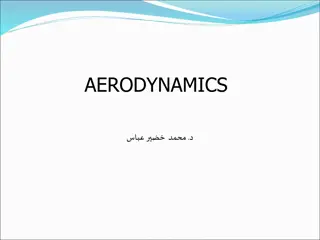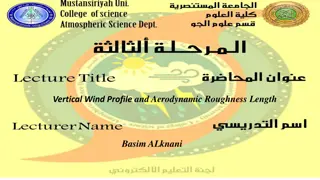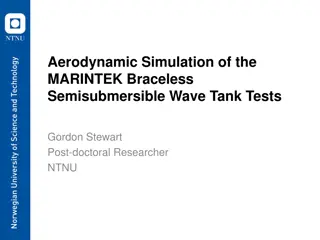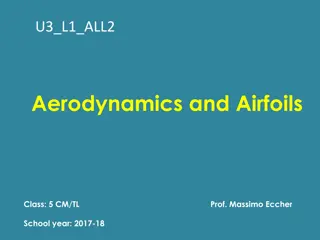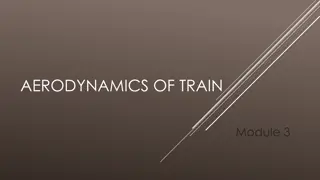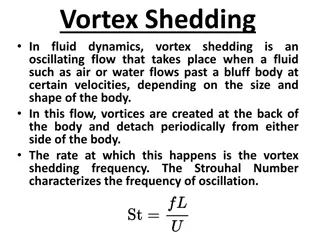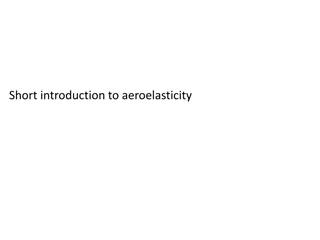Understanding Aerodynamic Forces and Moments in Fluid Dynamics
Introduction to aerodynamic forces and moments in the study of fluid dynamics, particularly focusing on air as the primary medium of interest. The discussion covers thermodynamic properties, continuum hypothesis, and fundamental principles of classical mechanics applied to the analysis of aerodynamics. Emphasis is placed on the modeling of flow fields and the development of theoretical frameworks based on conservation laws and fluid dynamics principles.
Download Presentation

Please find below an Image/Link to download the presentation.
The content on the website is provided AS IS for your information and personal use only. It may not be sold, licensed, or shared on other websites without obtaining consent from the author. Download presentation by click this link. If you encounter any issues during the download, it is possible that the publisher has removed the file from their server.
E N D
Presentation Transcript
Aerodynamic forces and moments Introduction The design of vehicles such as airplanes has advanced to the level where we require the wealth of experience gained in the investigation of flight over the past 100 years. The fluid of primary interest is air, which is a gas at standard atmospheric conditions. We assume that air s dynamics can be effectively modeled in terms of the continuum fluid dynamics of an incompressible or simple-compressible fluid. Air is a fluid whose local thermodynamic state we assume is described either by its mass density constant, or by the ideal gas law. In other words, we assume air behaves as either an incompressible or a simple-compressible medium, respectively. The equation of state, known as the ideal gas law, relates two thermodynamic properties to other properties and, in particular, the pressure. It is Private & Confidential
Aerodynamic forces and moments Introduction The thermodynamic properties of pressure, temperature, and density are assumed to be the properties of a mass-point particle of air at a location X= (x, y, z) in space at a particular instant in time, t. assume the measurement volume to be sufficiently small to be considered a mathematical point. Local thermodynamic equilibrium prevails within the mass-point particle at X and t regardless of how fast the thermodynamic state changes as the particle moves from one location in space to another. This is an acceptable assumption for our macroscopic purposes because molecular processes are typically faster than changes in the flow field we are interested in from a macroscopic point of view. Continuum hypothesis, which states that we can define all flow properties as continuous functions of position and time and that these functions are smooth, that is, their derivatives are continuous. This allows us to apply differential integral calculus to solve partial differential equations that successfully model the flow fields of interest Private & Confidential
Aerodynamic forces and moments Introduction To develop the theory, the fundamental principles of classical mechanics are assumed. They are Conservation of mass Newton s second law of motion First law of thermodynamics Second law of thermodynamics The principle of conservation of mass defines a mass-point particle, which is a fixed mass particle. Thus the principle also defines mass density , which is mass per unit volume. If a mass-point particle conserves mass, as we have postulated, then density changes can only occur if the volume of the particle changes. Newton s second law defines the concept of force in terms of acceleration ( F= ma ). The acceleration of a mass-point particle is the change in its velocity with respect to a change in time. Let the velocity vector u = (u, v, w); this is the velocity of a mass-point particle at a point in space, X=(x, y, z), at a particular instant in time t. Private & Confidential
Aerodynamic forces and moments Introduction The acceleration of this mass-point particle is The first is the local change in velocity with respect to time. The second takes into account the convective acceleration associated with a change in velocity of the mass- point particle from its location upstream of the point of interest to the observation point X at time t. We will also be interested in the spatial and temporal changes in any property f of a mass-point particle of fluid. These changes are described by the substantial derivative as follows: This equation describes the changes in any material property f of a mass point at a particular location in space at a particular instant in time. Eulerian viewpoint Private & Confidential
Aerodynamic forces and moments Introduction Aerodynamic Force and Moment Air flowing past an airplane, or any other body, must be diverted from its original path; such deflections lead to changes in air speed. Bernoulli s equation shows that the pressure exerted by the air on the airplane is altered from that of the undisturbed stream. Also, the viscosity of the air leads to frictional forces tending to resist the air s flow. As a result of these processes, the airplane experiences an aerodynamic force and moment. It is conventional and convenient to separate aerodynamic force and moment into three components each. Private & Confidential
Aerodynamic forces and moments Introduction Aerodynamic Force and Moment Lift, L (CZ Direction) Drag, D( X) Crosswind Force, Y Pitching Moment, M Rolling Moment, LR Yawing Moment, N Private & Confidential
Aerodynamic forces and moments Introduction We need lift for flying! Lift is the component of the force that a fluid flowing past a surface of a body exerts on it on the direction perpendicular to the oncoming flow direction. Drag is, in opposition to lift, the component of the force along the direction of the oncoming flow direction. How can we analyze aircrafts that are so different? Private & Confidential 8
Aerodynamic forces and moments Introduction: Forces Why airplanes can fly? We can easily remember the basic flight equations: a m F = And the forces that appear are: W = weight L = lift D = drag T = thrust If we wish to have a stable flight condition we have to compensate all the forces. Considering a generic case with a sustained turn of radius rc, we decompose this equation along the path direction: dV = = cos sin F T D W m || T dt 2 V = = sin cos F L T W m T r c Private & Confidential 9
Aerodynamic forces and moments Introduction: Coefficients L L = = C L 1 q S 2 V S 2 D D = = C D 1 q S 2 V S 2 M M = = C M 1 q S l 2 V S l ref ref 2 Where: is freestream density V is freestream velocity (flight speed) S is a reference area that depends on the specific problem q is freestream dynamic pressure lref is a reference lenght scale that also depends on the problem Private & Confidential 10
Aerodynamic forces and moments Introduction: Coefficients In the case of a 2D problem, we can adapt the coefficients, considering that l, d, and m are the lift, draf and moment of the 2D problem. l C = l 1 2 V c ref 2 d = C d 1 2 V c ref 2 m = C m 1 2 2 V c ref 2 Where: cref is a reference lenght scale that is usually the chord lenght of the airfoil Pressure coefficient p p = Cp 1 2 V 2 Private & Confidential 11
Aerodynamic forces and moments Aerodynamic forces: where do they came from? Any body immersed in a fluid is under the action of two kind of forces: Pressure forces: perpendicular to the surface and created by the elastic collisions of the molecules between the fluid and the body surface. Shear forces: tangent to the surface and produced by fluid viscosity. We will see later that, pressure forces are fortunately much bigger than shear forces in classical aerodynamic shapes. Example: a cylinder will have a Cd=1 (with reference length equal to its diameter), while a classical airfoil may have a Cd=0.008 (with reference length equal to its chord) Private & Confidential 12
Aerodynamic forces and moments Exercises 1. Consider the supersonic flow over a 5 half-angle wedge at zero angle of attack as sketched in the figure. The freestream parameters are M =2, p =1.01 105N/m2and =1.23 Kg/m3. The pressure on the upper and lower surfaces of the wedge are constant and equal to p1=1.31 105Pa. The pressure on the base of the wedge is p . The shear stress varies over both the upper and lower surfaces as w=431 s-0.2N/m2. The chord of the wedge is 2 m. Calculate the drag coefficient Private & Confidential 13
Aerodynamic forces and moments Exercises 2. In low speed and incompressible flow, we measure a NACA 4412 profile with an angle of attack of 4 , and we obtain: cl=0.85 cm c/4=-0.09 Calculate the location of the center of pressure. 3 Consider the DC3, Just outboard of the engine nacelle, the airfoil chord length is 4.6m. At cruising velocity 300km/h at sea level, the moment per unit span at this airfoil location is M (c/4) = -4850N.m/m and M LE =-14550N.m/m . Calculate the lift per unit span and the location of the center of pressure. Private & Confidential 14
Aerodynamic forces and moments Flow similarity Flow similarity between two flow fields The streamline patterns are geometrically similar The force coefficients are the same as a result of having the same distribution of p/p , V/V , T/T , when plotted against nondimensional coordinates. When do we have flow similarity? The bodies and boundaries are geometrically similar Both flows have the same similarity parameters In general, we can consider Re and M the only relevant similarity parameters Private & Confidential 15
Aerodynamic forces and moments Exercises 3. Consider the flow over two circular cylinders, one having four times the diameter of the other. The flow over the smaller cylinder has a freestream density, velocity and temperature given by 1, V1, and T1respectively, and over the larger cylinder 2, V2, and T2, where 2= 1/4, V2=2V1 and T2=4T1. Note: and a are proportional to T1/2 Demonstrate that the two flows are dynamically similar. Private & Confidential 16 Aerodynamics and aeroelasticity Daniel Redondo
Aerodynamic forces and moments Exercises 4. Consider an aircraft flying at 880km/h, FL380 in an environment at p =20700 Pa and T =-56 C We have a 1:50 scale model to be tested in a wind tunnel facility where the temperature is -34 C. Note: and a are proportional to T1/2 Calculate the required wind tunnel flow speed and pressure such that lift and drag coefficients in the WTT match the values for free flight. Private & Confidential 17 Aerodynamics and aeroelasticity Daniel Redondo
Aerodynamic forces and moments Typical Cdvalues Private & Confidential 18
Aerodynamic forces and moments Aerodynamic equations simplifications (I) The momentum Navier-Stokes equation is: ' 1 V V V V ( ) f V V D = + = + + + 2 p / L m 3 Dt t V 2 L 2 V / Analyzing the order of magnitude of the different terms we can find some simplifications. Viscosity can be neglected in general, except in certain areas (boundary layer, downwash, etc ) VL Re L L V 2 V V = 1 2 = 60 / m s Example analysis for a light aircraft: 5 . 1 = m 6 2 6 10 / Re 4 10 m s = 1 L Mass forces effects are much smaller than dinamic pressure effect, except in aerostatic ballons. gL 2 V Private & Confidential 19 Aerodynamics and aeroelasticity Daniel Redondo
Aerodynamic forces and moments Aerodynamic equations simplifications (II) The energy Navier-Stokes equation is: e ( ) + = + + V V e p k T v t Analyzing the order of magnitude of the different terms we can find some simplifications. Adiabatic hypotheis because heat transfer is neglectable if compared with transport terms. c Pr gas p = 1 1 Pr Pr Re k Barotropic hypothesis: we can define a unique relation between density and pressure across the fluid field. Liquids: Isentropic movement: cte p = = cte Private & Confidential 20 Aerodynamics and aeroelasticity Daniel Redondo
Aerodynamic forces and moments Simplified equations After all those simplification we obtain a compact expression of the equations: Continuity equation ( + t ) ( ) 0 = D = + V V Dt Momentum equation D ( ) 2 V V V V 1 = + = + = V V V V p 2 Dt t t Energy/entropy equation = t Dt Ds s + = V 0 s Equation of state liquid = cte = perfect gas p RT Private & Confidential 21
Aerodynamic forces and moments Limitations of the simplified equations We must remember all the hypothesis done in order to obtain those simplified equations. They will not be valid in limited areas like: Boundary layer Shock wave Any other small area where entropy grows But those areas are in general thin layers and although the impose strong constraints to the physics of the problem, the previous simplifications are still valid outside those regions. We will use two parameters to reflect the validity of our aproximations: Reynolds number: is the relation between the convective terms and the viscous terms. Mach number: is a measurement of the compressibility effects. As we increase the flow speed with respect to the speed of sound, the flow patterns and pressures can change dramatically. It is important to analyze this value locally and not only in the free stream. We may find compressibility effects in a high lift configuration with a free flow Mach of 0.3!! Private & Confidential 22
Aerodynamic forces and moments Typical modelizations and their hypothesis Equation Inviscid Irrotational Small perturbations Incompressible Notes Navier-Stokes Homogeneous RANS Modeled turbulence Euler X Full potential X X Transonic small disturbance X X X Prandtl-Glauert X X X Linearized Acoustic X X X Linearized Laplace X X X However, only a few of those cases can be solved analytically The first 4 methodologies progressively introduce more generic simplifications, while the last 4 rows represent equations that have been specifically derived from the potential equation in order to answer to certain simulations. Private & Confidential 23
Aerodynamic forces and moments The role of CFD and wind tunnel test CFD is the well know acronym for Computational Fluid Dynamics Most of the simulations performed nowadays in the industry are done through computational simulations. Looking at the aerodynamic simulations, we can hardly find industrial problems that can be solved analytically. The usual CFD codes (commercial or not) can solve many different problems. They have certain limitations, but in most cases, bad obtained results are not caused by a malfunctioning but by a bad use of the software or a mistake in the input parameters. We can easily generate impressive plots and animations but there is a narrow line between Color Fluid Dynamics and Color For Directors !! Why should I study analytical cases? They help to understand the basic aerodynamic principles A certain experience with analytical examples is required in order to assess the limitations of the CFD codes CFD code are not magical. They are built based on a certain modelization of the flow physics, and you cannot understand the limitations of the CFD unless you understand the limitations of the model itself. Private & Confidential 24
Aerodynamic forces and moments Potential movement The previous hypothesis (inviscid, adiabatic and barotropic relation in the flow filed) yield to the conservation of the rotor of the velocity, but in the free stream this rotational is 0, thus it will be 0 in any point. 1 Re = = f m Re p Pr 1 = = V 0 cte ( ) 0 ( ) p ; p That means that we can define a potential function = V After some manipulations we can obtain the Euler-Bernoulli equation: dp t 2 t 2 + 2 2 ( ) t + + = F that can be particularized for: 2 ( ) t + + = p G Liquids 2 2 a ( ) t where a is the local speed of sound p a Perfect gas + = G 1 t dp p = = = = 2 RT d S Private & Confidential 25
Aerodynamic forces and moments Potential movement: boundary conditions We have removed the terms with viscosity, thus we cannot expect null velocity on the wall. We know the shape of the body (given by the function F) and we can impose that the normal velocity with respect to the body surface is zero. = F t Dt DF F + = 0 ( 1 ) 2 If we had compressible terms there would be a factor thus we can assume errors below 10% if although we use the incompressible approach. 3 . 0 M M Private & Confidential 26
Aerodynamic forces and moments Potential movement 2D The incompressible approach in a 2D case yields the following equation: 0 = + zz xx = 0 We need to work in the plane and we can create a complex potential in order to manipulate the expressions more easily. Its real and imaginary part will be solutions of the Laplace equation. ( ) ( ) ( ) z x i z x t f , , + = where t is the position in the complex plane (x+i z) The first derivative return the conjugated velocity = ( ) t f = + + = i i U i W x x z z z + = = = 0 U xx zz x x + = = = 0 W xx zz z Private & Confidential 27
Aerodynamic forces and moments Potential movement 2D Stream line dx dz = ( ( ) ) ( ) , , U x z W x z ( ) = = = , , 0 0 U x z dz W x z dx dz dx d = W z x ( ) U z z from continuity the equation Stagnation point ( f ) 0 = t SP Remembering the complex variable theory, we know that the number of stream lines that connect this stagnation point is a function of the multiplicity of the root. o Simple root 2 stream lines o Double root 3 stream lines o Triple root 4 stream lines Mass flux between 2 stream lines ( ) ( A A ) = + = = B B F U dz W dx d B A Private & Confidential 28
Aerodynamic forces and moments Potential movement 2D Example potentials: Uniform flow ( ) ( ) t f = i f t U e t = = + i cos sin U e U i U U W Source / drain Q 2 Q Q ( ) t ( ) = = + ln ln f t t r i 0 ie r 2 2 = t t 0 o Source: o Drain: Stream lines are radial, with origin on the source/drain The flux through any closed line surrounding the singularity is Q Q>0 Q<0 Private & Confidential 29
Aerodynamic forces and moments Potential movement 2D Example potentials: Vortex ( ) t f i 2 i ( ) = = ln ln t t r 0 ie r 2 2 = t t 0 >0 <0 o Clockwise o Counterclockwise Stream lines are circumferences around the singularity Doublet It is the joint action of a source and a drain in t=a and t=-a ( ) ( ) a t t f + = 2 2 + 1 1 Q Q Q 2 a Q 2 a ( ) = ln ln ln ln t a t t t t 2 1 Q 2 a Q 2 a Qa 2 M + + = + = t t t t M i M e ( ) t = f The general expression would be t 0t Private & Confidential 30
Aerodynamic forces and moments Potential movement 2D The fact that the flow is always along a streamline and not through it, allows to substitute any streamline in an inviscid flow by a solid boundary without affecting the remainder of the flow pattern. If a streamline forms a closed curve, it separates the flow in to independent areas, and we can replace one of them by a solid body. This concept is employed in the mirror image methodology, where through the creation of singularities in the flow filed we achieve our solid body shape with one streamline. Online potential flow simulator: http://www.dept.aoe.vt.edu/~devenpor/aoe5104/ifm/ifm.html Private & Confidential 31
Aerodynamic forces and moments Potential movement 2D: flow around a cylinder The potential function that represents a cylinder in a uniform flow is: t ( ) = , U z x + t 2 a ( ) t = f U 2 a + 1 z the imaginary part is: + 2 2 x z 2 a ( ) = + , 1 x z U x and the real part is: + 2 2 x z = 0 d We remember that the streamline are defined by = = 0 0 streamline z In our case =constant if or x + = = 2 2 2 0 streamline z a + 1 2 a ( ) t f = U The conjugated velocity is 2 t ( ) t f = = = 2 2 0 t a t a And the stagnation points are Private & Confidential 32
Aerodynamic forces and moments Potential movement 2D: flow around a cylinder We can calculate the velocity over the cylinder wall: + + ( 1 ) 2 2 a a ( ) t f 2 = = = + = 2 + 2 i 1 1 1 cos sin U U U e U i 2 2 2 i t a e U W 2 + = = 2 2 2 4 sin 2 sin U W U V U The Bernouilli equation gives the pressure over the cylinder wall 1 2 = U 1 2 + = + 2 p V p U 2 2 p p V = = 2 1 1 4 sin c p 1 2 U 2 2 cp>0 V<U cp=1 V=0 1 p c cp<0 V>U cp=0 V=U Private & Confidential 33
Aerodynamic forces and moments Potential movement 2D: flow around a cylinder If we add a vortex in the center of the cylinder ( ) + i t 2 + t i 2 2 a = ln f t U t t U 2 1 a ( ) t f = + + 1 U 2 t The stagnation points are ( ) 0 = t f U 2 1 t a i + + = 1 0 2 2 t U iK 2 t i t where K is a non dimensional parameter + = 2 1 0 2 4 a a t = 1 K 2 iK the solutions are a Private & Confidential 34
Aerodynamic forces and moments Potential movement 2D: flow around a cylinder Let s analyze the stagnations points for the cylinder with circulation in an uniform flow t = 2 1 K iK a t = = K<1 sin sin cos K i a t K=1 = double iK a t = = 2 1 Ch Sh i K K i K>1 a Private & Confidential 35


